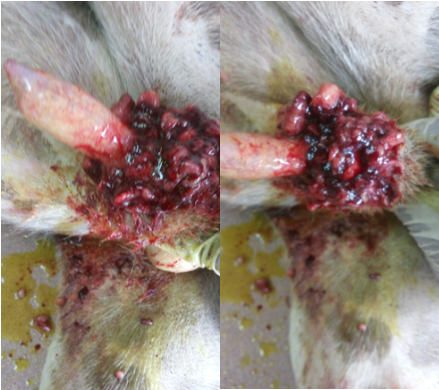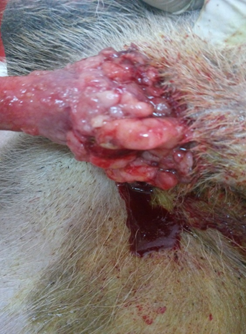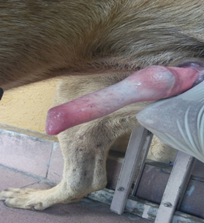Case Report
Volume 1 Issue 5 - 2017
Evaluation of a Topical Natural Product Formulation Catharanthusrosea and Cynodondactylon for the Treatment of Transmissible Venereal Tumour in a Male Dog: A Case Study.
Mines Pet Medicare Sdn. Bhd. CG-34, Blok C Seri Pulai, Taman Balakong Jaya, 43200 Kajang, SEL.D.E
*Corresponding Author: Shankar Ganesh K, Mines Pet Medicare Sdn. Bhd. CG-34, Blok C Seri Pulai, Taman Balakong Jaya, 43200
Kajang, SEL.D.E
Received: December 12, 2017; Published: December 20, 2017
Abstract
A 2 year old male stray dog was found to be bleeding from the penile sheath for two months. Physical examination by penile extrusion revealed a severe proliferative and haemorrhagic mass at the bulbar glandes. A natural product ointment was applied in an aerosol spray weekly to evaluate the progress of tumour regression. The reduction in size of the mass at the bulbar glandes was observed within seven days of treatment with the spray of a natural product, namely a liquid mixture of Catharanthusrosea and Cynodondactylon. Complete resolution of tumour mass was achieved in 4 weeks. The bleeding from the mass was halted within 24 hours of first spraying which exhibited a potent anti-inflammatory effect of local herbs. This preliminary study was conducted to establish the potential use of herbal plants for routine non-invasive treatment of transmissible venereal tumour in a male dog.
Keywords: Transmissible venereal tumour, Natural product therapy; Catharanthusrosea; Cynodondactylon
Case Study
The allopathic chemotherapy practices for tumour treatment in veterinary and medical treatment has been exposing patients to severe general systemic toxicity instead of selective cytotoxicity of cancer cells. Therefore, a natural product formulation according to Siddha practice was adopted to evaluate selected herbs known to be efficacious against tumour in human to be applied on a transmissible venereal tumour (TVT) in an infected dog.
Naturally occurring canine transmissible venereal tumour (TVT) is an important contagious neoplasm that commonly attacks the reproductive tract. This tumour widely spreads in free-roaming dogs. It is classified into two groups, genital TVT and extra genital TVT, according to the locations of the tumour mass present (Das and Das, 2000). Genital TVT is transmitted via natural mating while extra genital TVT is occurred by social contact, like sniffing or licking.
Prevalence varied upon the areas, for example, 11% in Kenya, 32% in Sri Lanka, 10% in Maryland (USA) and 23.5 to 28.6% in India (Das and Das, 2000). The clinical presentations for TVT are visible cauliflower-like mass in genital area or on skin surface with the presence of bloody discharge, ocular or nasal deformation from tumour invasion (Rogers, 1997; Mello Martins., et al. 2005). Cytological method is commonly used to diagnose the tumour because it is easy, less painful and less time consuming than biopsy. Treatments used to cure TVT are surgery, radiation or chemotherapy.
Surgical tumour removal does not only provide unsatisfactory response but also causes tumour recurrent. Thus, there is ever increasing interest in non-invasive methods of treatment especially using ethno veterinary methods such as herbal remedies. In this study, a 2 year old male stray dog s found to be bleeding from the penile sheath for two months was used to evaluate the effectiveness of using an herbal remedy as a spray after physical examination. It was diagnosed as having a severe proliferative and haemorrhagic mass at the bulbar glandes due to TVT.
With this interest, selected herbs harvested locally was washed, cleaned, cut into small pieces and air dried in shade before it was crushed into small pieces. The plants used in this study are Catharanthusrosea (Shahel., et al. 2014) and Cynodondactylon (Janani., et al. 2011). For the purpose of this study, the whole plant was used; which includes, leaves, stem, flowers and roots.
Catharanthus rose us is a plant species which belongs to the family Apocynaceae (Dogbane family) is known to the Siddha practitioners for thousands of years with the Tamil name, Nityakalyaani. It has been used to heal human cancer patients. This family contains mostly herbs and small shrubs. This family has smooth marginal leaves, flowers are found in leaf axils borne either singly or paired on very short stalks, and another distinguishable characteristic is potent milky sap.
The plant is exploited and studied as a medicinal plant as it was found to produce more than 100 monoterpenoid indole alkaloids that contain the two major vital cytotoxic dimeric alkaloids that are used for cancer chemotherapy treatment, also many alkaloids have a medicinal role. The compounds include the anti-cancer compounds: Vinblastine and Vincristine (Magnotta, 2006).
The alkaloid vincristine has a role for treating leukaemia in children. According to El-Sayed & Cordell (1981), US government screening program discovered incidentally that the Catharanthus extracts were antineoplastic in vitro that led ultimately to the licensing of the alkaloids such as vinblastine and vincristine, as well as some of the synthetic analogs today, as the highly toxic chemotherapy drugs. The absolute levels of vinblastine and vincristine are considered to be far too low in order to explain the activity of crude extracts of Catharanthus.
Cynodon dactylon, also known as Bermuda grass; well known as Arugampul to Tamil Siddha practitioners, is a grass where the blades are a grey-green colour and are short, usually 2–15 cm (0.79–5.91 in) long with rough edges. The erect stems can grow 1–30 cm (0.39–11.81 in) tall. The stems are slightly flattened, often tinged purple in colour. The seed heads are produced in a cluster of two to six spikes together at the top of the stem, each spike 2–5 cm (0.79–1.97 in) long (Shi., et al. 2012). Garg & Khosa, (2008), studied the, Analgesic and Anti-Pyretic activity of aqueous extract of Cynodon dactylon.
Whole plant of Cynodon dactylon is traditionally used to treat painful and inflammatory conditions. Analgesic and anti-pyretic activities of aqueous extract of Cynodon dactylon at different doses was studied using hot plate, acetic acid induced writhing and yeast induced hyperthermia method. Cynodon dactylon showed significant analgesic and anti-pyretic in all models studied. It was found that the aqueous extract at the dose of 600 mg/kg showed a significant decrease in rectal temperature similar to that shown by standard drug, paracetamol.
The fact that aqueous extract of Cynodon dactylon showed analgesic activity in both models studied, indicate that this effect could be due to the presence of two components; one acting centrally and the other via peripheral route. As it is commonly found in Malaysia, this grass was chosen for it’s the potential to be used in herbal remedies. The actual ingredient and formula is kept confidential for non-disclosure agreement purposes.
A known amount of the above two plants were crushed lightly, air dried for 48 hours and was then heated up to first boil in sesame oil to absorb active ingredients. The medicated oil was then filled in an aerosol can to be used as a spray. The stray dog was anesthetized to extrude the penis for thorough spray on proliferative TVT mass. Upon completion of spray application, the penis was retracted back into position and the dog was released after full recovery from anaesthesia.
The same procedure was repeated until the 4th week of spray. This dog was not treated with any other pharmaceuticals in order to evaluate the effect of the natural spray product and it was released to continue its stray life until it is caught again for daily spray treatment. The dog was fed with leftover feed from nearby restaurants and dog pellet. All procedures for this study was conducted by a certified veterinarian with no invasive procedures
The bleeding mass of TVT stopped haemorrhaging within 24 hours of first spray and the mass had started to regress within 2 weeks. The complete regression was achieved by 4th week at 4th spray treatment. Figure 1 shows the initial stage of proliferative and haemorrhagic stage. Figure 2 showed an excellent regression of tumour mass within 3 weeks of 2 sprays. The mass had completely regressed in 4 weeks of treatment leaving behind healthy normal penis (Figure 3).
Result
Results from this preliminary observations indicate the potential for homeopathic way of treating epithelial tumour in animal is novel and can be effective. In humans, natural remedy promises a nontoxic solution and a very cost effective treatment for patients, especially old and compromised patients with liver and kidney insufficiencies. In this case, no irritation was observed in the dog as he appeared normal. During the treatment (spraying process), the dog was monitored for vital signs and suffice to say the dog was otherwise healthy and fit.
The selected herbs, which are growing free in Malaysian tropical climate, could be further evaluated for bio active compounds responsible to exert apoptosis and tumour cell necrosis. The limitation of the product is that currently it is applied on epithelial tumour and not applicable for systemic tumour. The need for novel pharmaceutical products from the plant has attained a great interest in the present research world due to the cost and the higher side effects that are associated with the chemically manufactured drugs. Catharanthus roseus, which is a potent medicinal plant is commonly available in Malaysia.
Many of the pharmacological actions such as antimicrobial, antioxidant, anthelmintic, antifeedant, antisterility, antidiarrheal, antidiabetic effect have been exhibited by numerous studies where it is used to treat fatal diseases. Alkaloids were the major phytochemical constituent of this medicinal plant such as the alkaloids that occupies most of the parts of the plant (Gajalakshmi., et al. 2013).
Cynodon grass too is widely available and is a potential source of antipyretic which can be exploited for use in herbal remedies. A molecular biological research is vital to identify the mechanism of action of each herbal extract and its compounds separately. Further studies need to be carried out on more animals with more detailed biochemical analysis of the effects of the plant product.
Conclusion
In conclusion, the medical and veterinary industry awaits a safer and efficacious chemotherapy to alleviate all side effects due to current chemically synthesized drugs, in addition to minimize the cost for the cancer treatment. The cost effectiveness of cancer treatment may extend the use of a drug in a wider range of animals, especially pet, and save them from euthanasia and chronic drug toxicity. The successful treatment of TVT in the dog, albeit a case study, gives an indication that natural products could be used to treat venereal and other cancers. Therefore, with adequate funding the study could be extended to a biotechnological research to identify the responsible bio active compounds for future phytopharmaceutical development.
References
- Shahel Hossain., et al. International Journal of Bioassays 4.1 (2015): 3606-3610.
- Jananie RK., et al. “Determination of bioactive components of Cynodondactylon by GC-MS Analysis”. New York Science Journal 4.4 (2011): 16-20.
- Magnotta M., et al. “Identification of a low vindoline accumulating cultivar of Catharanthus roseus (L.)GDon. By alkaloid and enzymatic profiling”. Phytochemistry 67.16 (2006): 1758–1764.
- Gajalakshmi S., et al. “Pharmacological activities of Catharanthus roseus: A perspective review”. International Journal of Pharma and Bio Sciences 4.2 (2013): 431-439.
- El-Sayed A and Cordell GA. “Catharanthus alkaloids. XXXIV. Catharanthamine, a new antitumor bisindole alkaloid from Catharanthus roseus”. Journal of Natural Products 44.3 (1981): 289-293.
- Das U and Das AM. “Review of canine transmissible venereal tumor sarcoma”. Veterinary Research Communications 24.8 (2000): 545-556.
- Shi H., et al. “Analysis of natural variation in bermuda grass (Cynodon dactylon) reveals physiological responses underlying drought tolerance”. PLOS ONE 7.12 (2012): 53422.
- Garg VK and Khosa RL. “Analgesic and Anti-Pyretic activity of aqueous extract of Cynodon dactylon”. Pharmacologyonline 3 (2008): 12-18.
Citation:
Shankar Ganesh K. “Evaluation of a Topical Natural Product Formulation Catharanthusrosea and Cynodondactylon for the
Treatment of Transmissible Venereal Tumour in a Male Dog: A Case Study.” Multidisciplinary Advances in Veterinary Science 1.5 (2017):
214-218.
Copyright: © 2017 Shankar Ganesh K. This is an open-access article distributed under the terms of the Creative Commons Attribution License, which permits unrestricted use, distribution, and reproduction in any medium, provided the original author and source are credited.
































 Scientia Ricerca is licensed and content of this site is available under a Creative Commons Attribution 4.0 International License.
Scientia Ricerca is licensed and content of this site is available under a Creative Commons Attribution 4.0 International License.